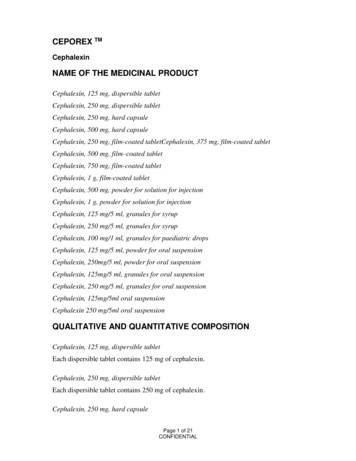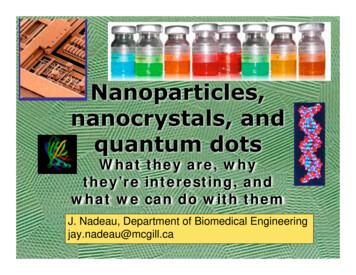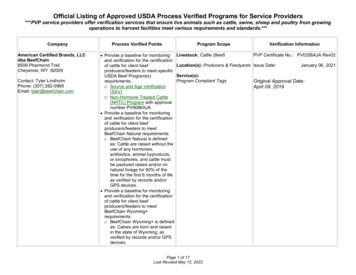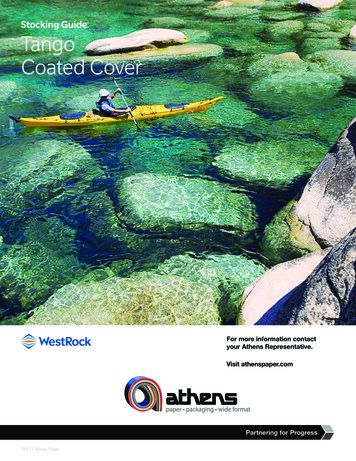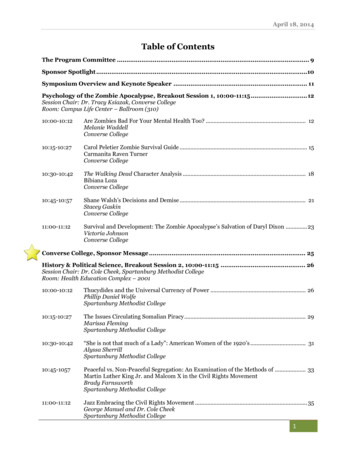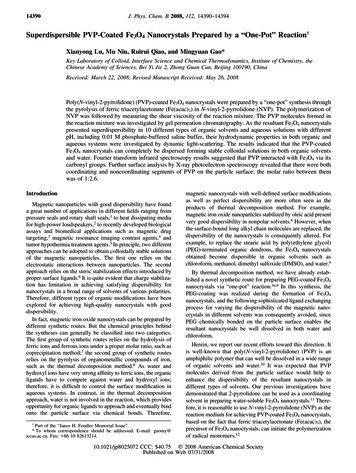
Transcription
14390J. Phys. Chem. B 2008, 112, 14390–14394Superdispersible PVP-Coated Fe3O4 Nanocrystals Prepared by a “One-Pot” Reaction†Xianyong Lu, Mu Niu, Ruirui Qiao, and Mingyuan Gao*Key Laboratory of Colloid, Interface Science and Chemical Thermodynamics, Institute of Chemistry, theChinese Academy of Sciences, Bei Yi Jie 2, Zhong Guan Cun, Beijing 100190, ChinaReceiVed: March 22, 2008; ReVised Manuscript ReceiVed: May 26, 2008Poly(N-vinyl-2-pyrrolidone) (PVP)-coated Fe3O4 nanocrystals were prepared by a “one-pot” synthesis throughthe pyrolysis of ferric triacetylacetonate (Fe(acac)3) in N-vinyl-2-pyrrolidone (NVP). The polymerization ofNVP was followed by measuring the shear viscosity of the reaction mixture. The PVP molecules formed inthe reaction mixture was investigated by gel permeation chromatography. As the resultant Fe3O4 nanocrystalspresented superdispersibility in 10 different types of organic solvents and aqueous solutions with differentpH, including 0.01 M phosphate-buffered saline buffer, their hydrodynamic properties in both organic andaqueous systems were investigated by dynamic light-scattering. The results indicated that the PVP-coatedFe3O4 nanocrystals can completely be dispersed forming stable colloidal solutions in both organic solventsand water. Fourier transform infrared spectroscopy results suggested that PVP interacted with Fe3O4 via itscarbonyl groups. Further surface analysis by X-ray photoelectron spectroscopy revealed that there were bothcoordinating and noncoordinating segments of PVP on the particle surface; the molar ratio between themwas of 1:2.6.IntroductionMagnetic nanoparticles with good dispersibility have founda great number of applications in different fields ranging frompressure seals and rotary shaft seals,1 to heat dissipating mediafor high-power loudspeakers,2 to recently developed biologicalassays and biomedical applications such as magnetic drugtargeting,3 magnetic resonance imaging contrast agents,4 andtumor hypothermia treatment agents.5 In principle, two differentapproaches can be adopted to obtain colloidally stable solutionsof the magnetic nanoparticles. The first one relies on theelectrostatic interactions between nanoparticles. The secondapproach relies on the steric stabilization effects introduced byproper surface ligands.6 It is quite evident that charge stabilization has limitation in achieving satisfying dispersibility fornanocrystals in a broad range of solvents of various polarities.Therefore, different types of organic modifications have beenexplored for achieving high-quality nanocrystals with gooddispersibility.In fact, magnetic iron oxide nanocrystals can be prepared bydifferent synthetic routes. But the chemical principles behindthe syntheses can generally be classified into two categories.The first group of synthetic routes relies on the hydrolysis offerric ions and ferrous ions under a proper molar ratio, such ascoprecipitation method;7 the second group of synthetic routesrelies on the pyrolysis of organometallic compounds of iron,such as the thermal decomposition method.8 As water andhydroxyl ions have very strong affinity to ferric ions, the organicligands have to compete against water and hydroxyl ions;therefore, it is difficult to control the surface modification inaqueous systems. In contrast, in the thermal decompositionapproach, water is not involved in the reaction, which providesopportunity for organic ligands to approach and eventually bindonto the particle surface via chemical bonds. Therefore,† Part of the “Janos H. Fendler Memorial Issue”.* To whom correspondence should be addressed. E-mail: gaomy@iccas.ac.cn. Fax: 86 10 82613214.magnetic nanocrystals with well-defined surface modificationsas well as perfect dispersibility are more often seen as theproducts of thermal decomposition method. For example,magnetic iron oxide nanoparticles stabilized by oleic acid presentvery good dispersibility in nonpolar solvents.8 However, whenthe surface-bound long alkyl chain molecules are replaced, thedispersibility of the nanocrystals is consequently altered. Forexample, to replace the stearic acid by poly(ethylene glycol)(PEG)-terminated organic dendrons, the Fe3O4 nanocrystalsobtained become dispersible in organic solvents such aschloroform, methanol, dimethyl sulfoxide (DMSO), and water.9By thermal decomposition method, we have already established a novel synthetic route for preparing PEG-coated Fe3O4nanocrystals via “one-pot” reaction.4a,b In this synthesis, thePEG-coating was realized during the formation of Fe3O4nanocrystals, and the following sophisticated ligand exchangingprocess for varying the dispersibility of the magnetic nanocrystals in different solvents was consequently avoided, sincePEG chemically bonded on the particle surface enables theresultant nanocrystals be well dissolved in both water andchloroform.Herein, we report our recent efforts toward this direction. Itis well-known that poly(N-vinyl-2-pyrrolidone) (PVP) is anamphiphilic polymer that can well be dissolved in a wide rangeof organic solvents and water.10 It was expected that PVPmolecules derived from the particle surface would help toenhance the dispersibility of the resultant nanocrystals indifferent types of solvents. Our previous investigations havedemonstrated that 2-pyrrolidone can be used as a coordinatingsolvent in preparing water-soluble Fe3O4 nanocrystals.11 Therefore, it is reasonable to use N-vinyl-2-pyrrolidone (NVP) as thereaction medium for achieving PVP-coated Fe3O4 nanocrystals,based on the fact that ferric triacetylacetonate (Fe(acac)3), theprecursor of Fe3O4 nanocrystals, can initiate the polymerizationof radical monomers.1210.1021/jp8025072 CCC: 40.75 2008 American Chemical SocietyPublished on Web 07/31/2008
“One-Pot” Preparation of PVP-Coated Fe3O4 NanocrystalsJ. Phys. Chem. B, Vol. 112, No. 46, 2008 14391Experimental SectionIron (III) acetylacetonate (Fe(acac)3) was purchased fromAldrich (14024-18-1, 97%, Aldrich) and used after two recrystallizations. NVP in medical grade was obtained from JiaozuoMeida Fine Chemical Co., Ltd. It was purified by distillationunder reduced pressure in the presence of phenothiazine. Allother chemicals of analytical grade were used as received.1. Synthesis of Fe3O4 Nanocrystals. The Fe3O4 nanocrystalswere synthesized by pyrolyzing Fe(acac)3 in NVP at 200 C.Typically, Fe(acac)3 was first dissolved in NVP at a concentration of 0.04 mol/L. The resultant solution was then purged withargon for 30 min at room temperature to remove oxygen, andsubsequently heated to 200 C. The reaction system wasprotected by argon throughout the whole reaction process.Different samples were extracted during the reaction at 200 C.Then an equal portion of ethanol was introduced followed by5-fold ether as precipitant. Black precipitates were isolated bya permanent magnet. After repeating the above-mentionedprocedures for three cycles using ethanol as solvent and etheras precipitant, the magnetic nanocrystals were finally obtained.The samples extracted at 3 and 6 h, denoted as samples A andB, respectively, were chosen for the following investigations.2. Production Rate of Fe3O4 Nanocrystals. The productionrate of the reaction was determined by comparing iron contentin the final products with that in the initially fed Fe(acac)3. Indetail, a nanocrystal sample was dissolved in hydrochloric acidsolution (36.5 wt %). Then excessive hydroxyamine hydrochloride was introduced to completely reduce Fe(III) to Fe(II). Thefinal content of Fe(II) in the solution was determined byphenanthroline method.13 The production rates of samples Aand B were of 45.3% and 60.2%, respectively.3. Characterizations. Transmission electron microscope(TEM) images and electron diffraction (ED) patterns were takenon a JEM-100CXII electron microscope at an accelerationvoltage of 100 kV. Powder X-ray diffraction (XRD) wasperformed on a Rigaku D/Max-2500 diffractometer under CuKR1 radiation (λ ) 1.54056 Å). Atomic force microscopy(AFM) was performed with a Digital Instruments NanoscopeIIIa Multimode System (Santa Barbara, CA). The hydrodynamicdiameter of the magnetic nanocrystals was determined with aMalvern Zetasizer Nano ZS instrument. The Fourier transforminfrared (FTIR) spectroscopy was taken on a Bruker EQUINOX55 FT-IR spectrometer under ambient conditions. Theroom-temperature shear viscosity of reaction system wasfollowed by TA AR2000 stress-controlled rheometer equippedwith two parallel plates of 25 mm in diameter. Gel permeationchromatography (GPC) measurements were performed by a setof Waters 1515 HPLC pumps, a 2414 differential refractometer,and Styragel columns (HT3, HT4, HT5) using dimethylformamide (DMF) as the eluent at 50 C. X-ray photoelectronspectroscopy data were obtained with an ESCALab220i-XLelectron spectrometer from VG Scientific using 300 W Mg KRradiation. The base pressure was about 3 10-9 mbar.Thermogravimetric analysis (TGA) was carried out on a PerkinElmer TGA. The samples were analyzed in a temperature rangeof 20-850 C with a temperature increasing velocity of 10 C/min under protection of nitrogen. The magnetic properties ofthe resultant samples were characterized by a vibrating samplemagnetometer (VSM JDM-13, China).ResultsFigure 1 shows the TEM images and ED patterns of particlesamples A and B, respectively. Statistical results revealed thatthe average sizes of sample A and sample B are 4.3 ( 0.8 nmFigure 1. TEM images and ED patterns of sample A (a) and sampleB (b).Figure 2. Powder X-ray diffractograms of sample A (solid line) andsample B (dashed line); Bottom: JCPDS card (19-0629) data formagnetite.Figure 3. Room-temperature magnetization curves of sample A (solidline) and sample B (dashed line).and 7.0 ( 1.5 nm, respectively. ED results indicate that bothof these two samples are composed of nanostructured materials.Their d-spacing values calculated match well with those fromthe JCPDS card (No. 19-0629) for magnetite, which were furtherproven by the XRD measurements shown in Figure 2.Further TGA measurements revealed that the polymer contentin these two samples was 36.2% for sample A and 25.0% forsample B, implying that PVP-coating was successfully realizedvia the current synthetic route. AFM was used to determine theoverall size of the polymer-coated nanoparticles sitting on thesurface of mica. Statistical results revealed that the average sizeof samples A and B were 6.9 ( 2.0 nm and 10.8 ( 1.9 nm,respectively.The magnetic properties of as-synthesized Fe3O4 nanocrystalswere measured by vibrating sample magnetometer (VSM). Theroom-temperature magnetization curves shown in Figure 3suggest that both samples are superparamagnetic with a saturation magnetization of 24.2 and 40.6 emu/g for samples A andB, respectively.
14392 J. Phys. Chem. B, Vol. 112, No. 46, 2008Lu et al.Figure 6. Temporal evolution of the shear viscosity of the reactionsolution.Figure 4. Photographs of sample B dispersed in different types oforganic solvents. The photographs were captured in the absence (left)or presence (right) of a permanent magnet.Figure 5. Photographs of sample B dispersed in aqueous solutions ofdifferent pH and 0.01 M PBS buffer. The photographs were capturedin the absence (left) or presence (right) of a permanent magnet.The dispersibility of the magnetic nanocrystals was testedby dispersing sample B in different types of solvents at aconcentration of 2.3-9.7 mg/mL. Ten different organic solvents,i.e., R-pyrrolidone, DMSO, methanol, DMF, acetic acid, nitromethane, pyridine, CHCl3, ethanol, and CH2Cl2, were adoptedin addition to water. The polarities of the solvents varied from3.4 to 10.2 (water). Figure 4 exhibits the photographs of theresultant magnetic fluids, captured in the absence or presenceof a permanent magnet. It was found out that the tilt angle ofthe magnetic fluid surface induced by the external magnetic fieldstrongly depends on the density of the solvent. In addition, thedispersibility of sample B in water of different pH values (3.0,6.1, 11.0), as well as 0.01 M phosphate-buffered saline (PBS)buffer was also tested, and the photographs of the resultantmagnetic fluids are shown in Figure 5.DiscussionThermally decomposing organometallic precursors in variousnonaqueous media has become a mainstream approach forsynthesizing high quality nanocrystals. Different from the typicalhigh-boiling-point solvents such as 1-octadecene, phenyl ether,and dioctyl ether, the current synthetic approach adopted strongpolar NVP as the reaction media. As NVP is structurally similarto R-pyrrolidone, it was also supposed to be a coordinatingsolvent.11 In addition, NVP is also a radical monomer that isreadily polymerized. Because Fe(acac)3, as one of most popularprecursors used in synthesizing magnetic iron oxide nanocrystals, can also initiate the polymerization of radical monomers,NVP was used as both the coordinating solvent as well as theradical monomer for preparing PVP-coated Fe3O4 nanocrystalsupon pyrolysis of Fe(acac)3.The polymerization of NVP was monitored by measuring theshear viscosity of a 1 mL reaction mixture extracted at a fixedtime interval during the reaction. The measurements wereperformed at 25 C by a shear rate of 10 s-1. The curve shownin Figure 6 depicts the reaction time-dependent shear viscosity,which increases slowly during the first 3 h, followed by a fastincrease until the whole reaction solution became too sticky tobe extracted, which strongly suggests that NVP was polymerizedand formed PVP during the formation of Fe3O4 nanoparticles.The fast increase in the viscosity during the late stage of thereaction is possibly caused by the intermolecular cross-linkingof PVP,14 which is supported by the fact that the magneticparticle samples obtained by a reaction time longer than 6 hpresented greatly reduced dispersibility in either organic solventsor water. Therefore, the preparation was generally terminatedbefore 6 h.The polymerization of NVP was also investigated by FTIRspectroscopy. The FTIR spectra of NVP and samples A and Bare provided in the upper frame of Figure 7. The typicalvibrational bands of the vinyl group from NVP, located at 1629cm-1 and 983 cm-1, completely disappear in the spectra of bothsamples A and B,15 suggesting that NVP has been polymerized.Taking the organic contents, i.e., 36.2% and 25.0% in samplesA and B, respectively, into consideration, it can be deducedthat PVP formed upon polymerization of NVP is present in thenanocrystal samples. The shift of the vibrational band of thecarbonyl group from 1680 cm-1 to 1661 cm-1 in the nanocrystalsamples, however, suggests that PVP is modified on the surfaceof the Fe3O4 nanocrystals via coordination interaction throughits carbonyl group.16 The sharp absorption peak at around 575cm-1 is attributed to lattice absorption of the Fe3O4 particles.The polymerization of NVP was further investigated bymeasuring the molecular weight of PVP molecules found inliquors containing nanocrystal samples A and B, respectively,using the GPC method. The results are shown in Figure 7. Thenumber-average molecular weight of PVP was determined tobe 5.17 104 and 4.14 104, respectively, using polystyrenestandards as references. The slight decrease in molecular weightof PVP found in liquors containing sample B is probably caused
“One-Pot” Preparation of PVP-Coated Fe3O4 NanocrystalsJ. Phys. Chem. B, Vol. 112, No. 46, 2008 14393TABLE 1: The Hydrodynamic Size of Sample B in AqueousSolution with Different pHpH value2.03.05.06.17.49.011.0hydrodynamic size (nm) 20.3 21.9 21.1 18.3 20.7 24.6 22.1fwhm (nm)5.8 6.5 6.4 6.1 6.3 6.6 6.3Figure 7. Upper frame: FTIR spectra of NVP (a), sample A (b), andsample B (c). Lower frame: GPC traces of PVP presented in the liquorsextracted at 3 h (solid line) and 6 h (dashed line) during the reaction.Since the dispersibility of the nanocrystals in physiologicalsaline is a very important prerequisite for biomedical applications of the magnetic nanocrystals, the dispersibility of sampleB was also tested in 0.01 M PBS buffer. The hydrodynamicsize was determined to be 20.7 nm, suggesting that theas-prepared Fe3O4 nanocrystals can well be dissolved in buffersaline.The superdispersibility of the Fe3O4 nanocrystals is undoubtedfully attributed to the surface-bound PVP. Although FTIRspectroscopy results indicate that PVP molecule coordinates withFe3O4 particles via its carbonyl group, more detailed informationregarding the surface binding situation remains important toreveal the superdispersibility of the resultant Fe3O4 nanocrystals.To fulfill this task, systematic XPS investigations were performed. The survey XPS spectrum of sample B together withthe spectra of O 1s and N 1s are shown in Figure 8. All thebinding energies are calibrated with reference to C 1s (284.8ev) of adventitious carbon. The spectra of O 1s and N 1s werefitted by multiple Gaussians with an equal full width at half-by intermolecular cross-linking among higher molecular weightPVP, which eventually leads to nonsoluble gel. In fact, NVP isalso a thermal polymerization monomer. Nevertheless, thepolydispersity index (PDI) of PVP found in reaction mixturescontaining sample A and sample B was calculated to be 1.18and 1.27, respectively, which somehow suggests that, even ifthe thermal polymerizing mechanism took effect, it would notbe a dominant procedure as the thermal polymerization oftengives rise to a much higher PDI.As the Fe3O4 nanocrystals presented very good dispersibilityin different types of organic solvents as shown in Figure 4, theirhydrodynamic properties were investigated for excluding suspensions of particle aggregations. The hydrodynamic size ofsample B in the following solvents, i.e., R-pyrrolidone, DMSO,methanol, DMF, acetic acid, nitromethane, pyridine, CHCl3,ethanol, and CH2Cl2, was determined to be 29.1 nm, 33.7 nm,28.8 nm, 26.1 nm, 24.8 nm, 22.3 nm, 31.2 nm, 18.8 nm, 25.5and 38.3 nm, respectively. In general, the hydrodynamic sizeof the magnetic nanocrystals varies in different type of solvents,but in a very small size regime. This variation is probably causedby the difference in the solubility parameter of the solvents,even though no regular dependency is found. Nevertheless, thehydrodynamic properties of the magnetic nanocrystals stronglysupport that the magnetic nanocrystals are well dispersed in allthe above-mentioned solvents with particles being separatedfrom each other.In addition to organic solvents, the Fe3O4 nanocrystalsobtained also present good dispersibility in aqueous solution.The hydrodynamic sizes of sample B were measured in aqueoussolutions of different pH values (2.0, 3.0, 5.0, 6.1, 7.4, 9.0, 11.0)by the DLS method, and the results are given in Table 1. Ingeneral, the hydrodynamic size of sample B presents very smallpH-dependent effects, ranging from 18 to 24 nm. The relativelypH-independent hydrodynamic size suggests that the nanocrystals present very good colloidal stability in a very broad pHrange. Moreover, the nanocrystal solutions present a very goodlong-term stability. In neutral pH range, the colloidal solutionremains highly stable for more than 1 year in a refrigerator.Figure 8. Survey X-ray photoelectron spectrum (a), N 1s (b) and O1s (c) spectra of sample B. The bold lines shown in frames b and c arethe best fits for N 1s and O 1s, respectively.
14394 J. Phys. Chem. B, Vol. 112, No. 46, 2008maximum (fwhm) using a Shirley-type background. The fittingresults reveal that the binding energy of N 1s remains unchangedin comparison with that in pure PVP,17 further supporting thatPVP coordinates with Fe3O4 nanocrystals via its carbonyl group.The O 1s line was fitted with a convolution of three peaks, i.e.,529.8, 531.0, and 531.9 eV, corresponding to three different Ochemical states. According to reference data, the first peak canbe assigned to O from magnetite,18 the second peak (531.0 eV)can be assigned to uncoordinating O in PVP,17 while the lastpeak can be attributed to O from PVP coordinating with theFe3O4 nanocrystals.19 On the basis of this analysis, the ratiobetween the coordinating and noncoordinating PVP segmentsis approximately 1:2.6, well interpreting the superdispersibilityof the Fe3O4 nanocrystals stabilized by PVP since the coordinating PVP segments offer stabilization effects to the Fe3O4nanocrystals and prevent them from uncontrollable growth,while the noncoordinating PVP segments provide the resultantnanocrystals dispersibility in different types of solvents.ConclusionIn summary, PVP-coated Fe3O4 nanocrystals were preparedby a “one-pot” synthesis through the pyrolysis of Fe(acac)3 inNVP. In this synthetic route, Fe(acac)3 serves as the precursorof magnetite, and NVP serves as a radical monomer of PVP.Both FTIR and XPS results reveal that the resultant PVPcoordinates with Fe3O4 nanocrystals via carbonyl groups, as thenoncoordinating segment is 2.6 times that of the coordinatingsegments of PVP. Consequently, the resultant PVP-coated Fe3O4nanocrystals present similar dissolvability to pure PVP and canform stable solutions in a great number of organic solvents aswell as water solutions of different pH (including PBS buffer).All these results demonstrate that the current synthetic route isvery facile and effective for achieving highly soluble andcolloidally stable Fe3O4 nanocrystals. Their superdispersibilityin both organic and aqueous media may offer potential applications of the superparamagnetic nanocrystals in different fields.Acknowledgment. The current investigations were financiallysupported by NSFC projects (20673128, 20640430564) and 863projects (2006AA02Z479, 2007AA02Z467).Lu et al.References and Notes(1) Black, T.; Raj, K.; Tsuda, S. J. Magn. Magn. Mater. 2002, 252,39.(2) Odenbach, S. J.Phys.: Condens. Matter 2004, 16, R1135.(3) (a) Lübbe, A. S.; Alexiou, C.; Bergemann, C. J. Surg. Res. 2001,95, 200. (b) Ganguly, R.; Gaind, A. P.; Sen, S.; Puri, I. K. J. Magn. Magn.Mater. 2005, 289, 331.(4) (a) Li, Z.; Wei, L.; Gao, M.; Lei, H. AdV. Mater. 2005, 8, 1001.(b) Hu, F.; Wei, L.; Zhou, Z.; Ran, Y.; Li, Z.; Gao, M. AdV. Mater. 2006,18, 2553. (c) Song, H-T.; Choi, J-S.; Huh, Y-M.; Kim, S.; Jun, Y-W.; Suh,J-S.; Cheon, J. J. Am. Chem. Soc. 2005, 127, 9992.(5) (a) Hiergeist, R.; Andrä, W.; Buske, N.; Hergt, R.; Hilger, I.;Richter, U.; Kaiser, W. J. Magn. Magn. Mater. 1999, 201, 420. (b) Gonzales,M.; Krishnan, K. M. J. Magn. Magn. Mater. 2005, 293, 265.(6) (a) Thomas, K. G.; Ipe, B. I.; Sudeep, P. K. Pure. Appl. Chem.2002, 74, 1731. (b) Roucoux, A. Top. Organomet. Chem. 2005, 16, 261.(7) (a) Dumazet-Bonnamour, I.; Perchec, P. Colloid Surf., A 2000, 173,61. (b) Pardoe, H.; Chua-anusorn, W.; Pierre, T. G. S.; Dobson, J. J. Magn.Magn. Mater. 2001, 225, 41. (c) Wan, S.; Zheng, Y.; Liu, Y.; Yan, H.;Liu, K. J. Mater. Chem. 2005, 15, 3424.(8) (a) Sun, S.; Zeng, H. J. Am. Chem. Soc. 2002, 124, 8204. (b) Park,J.; An, K.; Hwang, Y.; Park, J. G.; Noh, H. J.; Kim, J. Y.; Park, J. H.;Hwang, N. M.; Hyeon, T. Nat. Mater. 2004, 3, 891. (c) Jana, N. R.; Chen,Y.; Peng, X. Chem. Mater. 2004, 16, 3931. (d) Casula, M. F.; Jun, Y.;Zaziski, D. J.; Chan, E. M.; Corrias, A. C.; Alivisatos, A. P. J. Am. Chem.Soc. 2006, 128, 1675.(9) Kim, M.; Chen, Y.; Liu, Y.; Peng, X. AdV. Mater. 2005, 17, 1429.(10) Cui, Y. D.; Yi, G. B.; Liao, L. W. Synthesis and Applications ofPoly(N-Vinyl-2-pyrrolidone); Science Press: China, 2001.(11) (a) Li, Z.; Chen, H.; Bao, H.; Gao, M. Chem. Mater. 2004, 16,1391. (b) Li, Z.; Sun, Q.; Gao, M. Angew. Chem., Int. Ed. 2005, 44, 123.(12) Prabha, R.; Nandi, U. S. J. Polym. Sci., Polym. Lett. Ed. 1976, 14,19.(13) Taras, M. J.; Greenberg, A. E.; Hoak, R. D.; Rand, M. C. StandardMethods for the Examination of Water and Wastewater, 13th ed.; AmericanPublic Health Association: Washington, DC, 1971.(14) (a) Yoshida, M.; Prasad, P. N. Appl. Opt. 1996, 35, 1500. (b) Zheng,M.-P.; Jin, Y.-P.; Jin, G.-L.; Gu, M.-Y. J. Mater. Sci. Lett. 2000, 19, 433.(15) Doneux, C.; Caudano, R.; Delhalle, J.; Léonard-Stibbe, E.; Charlier,J.; Bureau, C.; Tanguy, J.; Lécayon, G. Langmuir 1997, 13, 4898.(16) Nemamcha, A.; Rehspringer, J-L.; Khatmi, D. J. Phys. Chem. B2006, 110, 383.(17) Beamson, G.; Briggs, D. High Resolution XPS of Organic Polymers:The Scienta ESCA300 Database; John Wiley & Sons: Chichester, U.K.,1992.(18) (a) Krasnikov, S. A.; Vinogradov, A. S.; Hallmeier, K. H.; Höhne,R.; Ziese, M.; Esquinazi, P.; Chass, T.; Szargan, R. Mater. Sci. Eng. B2004, 109, 207. (b) Zhang, Y.; Sun, C.; Kohler, N.; Zhang, M. Biomed.MicrodeVices 2004, 6, 33.(19) Lee, H. Y.; Lim, N. H.; Seo, J. A.; Yuk, S. H.; Kwak, B. K.; Khang,G.; Lee, H. B.; Cho, S. H. J. Biomed. Mater. Res., Part B: Appl. Biomater.2006, 79B, 142.JP8025072
followed by TA AR2000 stress-controlled rheometer equipped with two parallel plates of 25 mm in diameter. Gel permeation chromatography (GPC) measurements were performed by a set of Waters 1515 HPLC pumps, a 2414 differential refractometer, and Styragel columns (HT3, HT4, HT5) using dimethylforma-mide (DMF) as the eluent at 50 C. X-ray .
